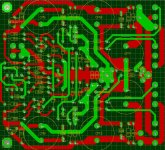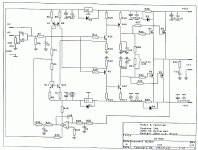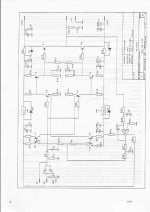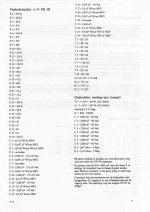I came across an old A18 amplifier with one defectice channel. After repairing the amp I found that the sound was open and transparent as well as the sound stage wide and in 3D.
As this was with my nearfields I use in the studio I wanted to go on a n adventure to use these for my Orion and designed a PCB so I can build 8 channels.
The beauty of these amp is a high quiescent current and about 30W output without feedback.
You can find the schematic idea on the web.
As I'm planning to build 8 channels and 2 reserve I could order some more if there is interest. The price would be around 7 euro's per channel for the PCB.
2mm FR4 and 2Oz copper.
Do not worry about the 2SJ162 and 2SK1058 as I have plenty NOS parts I only want to sell with the PCB's.
The 78x12 regulator may oscilate when using the indicated 2200u cap on the output. Oscilation disappears when reducing the cap to 47u.
As this was with my nearfields I use in the studio I wanted to go on a n adventure to use these for my Orion and designed a PCB so I can build 8 channels.
The beauty of these amp is a high quiescent current and about 30W output without feedback.
You can find the schematic idea on the web.
As I'm planning to build 8 channels and 2 reserve I could order some more if there is interest. The price would be around 7 euro's per channel for the PCB.
2mm FR4 and 2Oz copper.
Do not worry about the 2SJ162 and 2SK1058 as I have plenty NOS parts I only want to sell with the PCB's.
The 78x12 regulator may oscilate when using the indicated 2200u cap on the output. Oscilation disappears when reducing the cap to 47u.
Attachments
Last edited:
about 30W output without feedback.
Forgive me if I'm wrong, but aren't R19/R20 providing global negative feedback via U3?
Who has ever heard about Hawk?
In memoriam
In deze column dwaal ik af naar de jaren 80 van de vorige eeuw, een gouden eeuw voor de audio. En de opkomst en ondergang van een van de meest boeiende bladen die Nederland kende: Audio & Techniek. - Audio-Creative
In memoriam John van der Sluis
John was also a diyA member : Good Morning World!
John's lifetime dream was to be a Jean Hiraga (equivalent)
Single flaw he had was his neverending adorating/talk for/on Art Blakey and his overdeveloped love of big bands.
Frits Savelkoul (flunked TUE electronics student, Indonesian bloke) developed the A80 hybrid valve/lateral MOSFET monaural power amp for/with A&T in 1988.
Full Class A 80W output on 4 pairs of 2SJ50/2SK135, valve input stage with 6SQ7 (back in the late 80s a costly valve) and E80CC.
High parts count design, 1000W toroidal transformer for the output stage, ~100.000uF smoothing capacitors (Frits had a liking for pricy SIC SAFCO caps)
Full diy build by the advised BOM (including purchase price of the drawings, amounted to around fl4000 for an A80 pair.
Frits also designed a valve preamp, including phono stage, which was even more costly to build than the power amp.
After that the cooperation between Frits and John vd Sluis/A&T ended.
A year later,1989, John vd S recruited a pair of HTS electronic students to develop a stripped down copycat version of the A80, named the A25, as their graduation project (1990).
Single pair of Lateral MOSFETS in the output stage, ECC88/E88CC for the input stage.
Another year later, 1991, A&T came out with an even less costlier design, the A15, valves exchanged for a complementary differential input stage with 5 cents each BC546/556
Couple of years later he beefed up the A15 by doubling the number of output stage devices and adding a class a/b switch (as in the A80)
At the end of the 90s, John vd Sluis had to shut down Audio & Techniek (2nd time in it's history), went to Belgium at age 63 and set up Hawk Audio there.
John offered boards and complete amp kits for quite a number of years from his Belgium residence adress. If my memory serves me right, Hawk Audio remained registered in Belgium after John relocated to France.
Interesting fella, enjoyable, and quite the audio-addict despite his continuous commercial aspirations.
(I first met Guido Tent at one of John vd S A&T gatherings, at the time Guido was in his 2nd year at the Eindhoven HTS, worked parttime for Ed de Jong, must have been in his very early 20)
Full Class A 80W output on 4 pairs of 2SJ50/2SK135, valve input stage with 6SQ7 (back in the late 80s a costly valve) and E80CC.
High parts count design, 1000W toroidal transformer for the output stage, ~100.000uF smoothing capacitors (Frits had a liking for pricy SIC SAFCO caps)
Full diy build by the advised BOM (including purchase price of the drawings, amounted to around fl4000 for an A80 pair.
Frits also designed a valve preamp, including phono stage, which was even more costly to build than the power amp.
After that the cooperation between Frits and John vd Sluis/A&T ended.
A year later,1989, John vd S recruited a pair of HTS electronic students to develop a stripped down copycat version of the A80, named the A25, as their graduation project (1990).
Single pair of Lateral MOSFETS in the output stage, ECC88/E88CC for the input stage.
Another year later, 1991, A&T came out with an even less costlier design, the A15, valves exchanged for a complementary differential input stage with 5 cents each BC546/556
Couple of years later he beefed up the A15 by doubling the number of output stage devices and adding a class a/b switch (as in the A80)
At the end of the 90s, John vd Sluis had to shut down Audio & Techniek (2nd time in it's history), went to Belgium at age 63 and set up Hawk Audio there.
John offered boards and complete amp kits for quite a number of years from his Belgium residence adress. If my memory serves me right, Hawk Audio remained registered in Belgium after John relocated to France.
Interesting fella, enjoyable, and quite the audio-addict despite his continuous commercial aspirations.
(I first met Guido Tent at one of John vd S A&T gatherings, at the time Guido was in his 2nd year at the Eindhoven HTS, worked parttime for Ed de Jong, must have been in his very early 20)
I worked with Audio & Techniek at the time (1989) and I remember Frits' amplifiers. The A80 was very large, heavy, expensive and it got hot. Frits told me once that when he switched it on at home, the 16A 220V house breaker tripped (de stop sloeg door). So overall not a great design for people to build without trouble. The pre-amp, humbly baptized T.O.A.S. (The Only Absolute Standard  ) by Fritz, was not a success either. Too big and it never came out of the experimental stage. I think Frits came up with a simplified version later on.
) by Fritz, was not a success either. Too big and it never came out of the experimental stage. I think Frits came up with a simplified version later on.
So the A25 was not a copycat project but an attempt to put the knowledge and experience from the A80 into a more realistic and workable design for the hobbyist. And use components that were readily available instead of components from the surplus store in Vlaardingen.
I'm not trying to discredit Frits here. He was a nice guy and I liked him. He was enthusiastic and came up with interesting and different designs but they were not always compatible with the context of the audio magazine. Even after Frits left A&T and got a full time job, he dropped by the A&T office every so often for a chat and a coffee.
Jacco, we may have met at the A&T shows. I was the 2m tall guy that started the modified Philips HF309 revival. I also met Guido Tent at the A&T shows and more or less got Eelco Grimm on the audio track by lending him my pile of Audio & Techniek magazines. I knew Eelco from a student club in Delft. Good memories.
Menno
So the A25 was not a copycat project but an attempt to put the knowledge and experience from the A80 into a more realistic and workable design for the hobbyist. And use components that were readily available instead of components from the surplus store in Vlaardingen.
I'm not trying to discredit Frits here. He was a nice guy and I liked him. He was enthusiastic and came up with interesting and different designs but they were not always compatible with the context of the audio magazine. Even after Frits left A&T and got a full time job, he dropped by the A&T office every so often for a chat and a coffee.
Jacco, we may have met at the A&T shows. I was the 2m tall guy that started the modified Philips HF309 revival. I also met Guido Tent at the A&T shows and more or less got Eelco Grimm on the audio track by lending him my pile of Audio & Techniek magazines. I knew Eelco from a student club in Delft. Good memories.
Menno
Last edited:
when I was 13, John vd sluis worked at van Dam electronics,and I built my first amplifier ,from a schematic provided by the store. (the amplifier drew a lot of current,at the time I did not realize it was oscillation). I took it in a shoebox on my bicycle to the shop, where John vdsluis spent all afternoon combating the oscillation with extra networks. he told me to buy the original PCB or maybe even gave me one for free ,to rebuild the amp. the schematic was a quad 303 clone, as his friend was a tech at transtec, the quad importer in the same city of rotterdam. 10 years later I was invited to demo my wooden tonearm at transtec with one of their sonus carttriges. transtec had pioneered to copy the famous pritchard tonearm, as pritchard had stopped production because "all his family members and friends had one". my neighbour and early hifi adept had made the drawing to produce the copies.
Last edited:
So the A25 was not a copycat project
Menno,
excuse my poor choice of words, scaled down would be more appropiate.
An ECC88 (or E88CC) comes at a fraction of the cost compared to the one of both 6SQ7+E80CC, same for a single J50/K135 pair compared to 4 pairs, as goes for all other parts of the A25/A80 designs.
From the start, the main focus/objective of A&T and John vd Sluis had been on buildable and high cost-effective designs, the best example is JvdS' Pijpluidspreker.
A&T had already started developing high bias MOSFET output stage designs of low complexity in the mid 80s : A10, A15mkI, A15mkII.
The A25 and A18 can/should be viewed as further developments of the A10/A15.
I recall both your name and face (linkedin page), I read the pages in A&T magazine you wrote and we spoke a couple of times at A&T meetings.
The A18 reminds a bit of the K.Lang amplifier : 2 pair Lateral MOSFET output stage and high quiescent current.
I've assembled a number of the A&T amps and agree with Tarasque, good sounding amplifier for the cost/ease of building (a great choice for active purposes)
- Home
- Group Buys
- PCB for the HAWK A18 amplifier (+ FETs if required)



